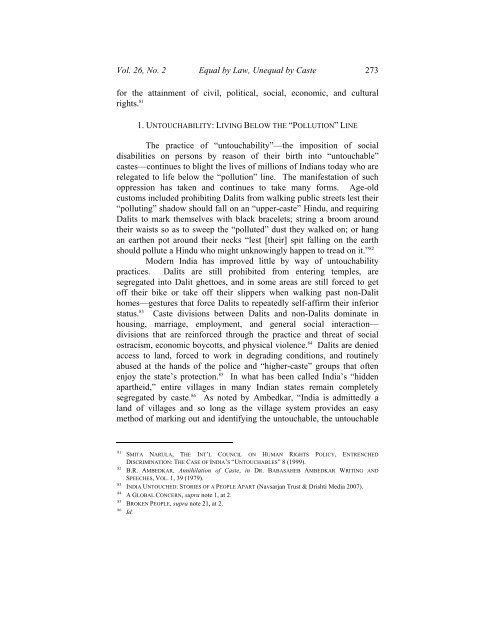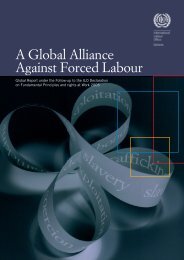equal by law, unequal by caste - International Dalit Solidarity Network
equal by law, unequal by caste - International Dalit Solidarity Network
equal by law, unequal by caste - International Dalit Solidarity Network
You also want an ePaper? Increase the reach of your titles
YUMPU automatically turns print PDFs into web optimized ePapers that Google loves.
Vol. 26, No. 2 Equal <strong>by</strong> Law, Un<strong>equal</strong> <strong>by</strong> Caste 273for the attainment of civil, political, social, economic, and culturalrights. 811. UNTOUCHABILITY: LIVING BELOW THE “POLLUTION” LINEThe practice of “untouchability”—the imposition of socialdisabilities on persons <strong>by</strong> reason of their birth into “untouchable”<strong>caste</strong>s—continues to blight the lives of millions of Indians today who arerelegated to life below the “pollution” line. The manifestation of suchoppression has taken and continues to take many forms. Age-oldcustoms included prohibiting <strong>Dalit</strong>s from walking public streets lest their“polluting” shadow should fall on an “upper-<strong>caste</strong>” Hindu, and requiring<strong>Dalit</strong>s to mark themselves with black bracelets; string a broom aroundtheir waists so as to sweep the “polluted” dust they walked on; or hangan earthen pot around their necks “lest [their] spit falling on the earthshould pollute a Hindu who might unknowingly happen to tread on it.” 82Modern India has improved little <strong>by</strong> way of untouchabilitypractices. <strong>Dalit</strong>s are still prohibited from entering temples, aresegregated into <strong>Dalit</strong> ghettoes, and in some areas are still forced to getoff their bike or take off their slippers when walking past non-<strong>Dalit</strong>homes—gestures that force <strong>Dalit</strong>s to repeatedly self-affirm their inferiorstatus. 83 Caste divisions between <strong>Dalit</strong>s and non-<strong>Dalit</strong>s dominate inhousing, marriage, employment, and general social interaction—divisions that are reinforced through the practice and threat of socialostracism, economic boycotts, and physical violence. 84 <strong>Dalit</strong>s are deniedaccess to land, forced to work in degrading conditions, and routinelyabused at the hands of the police and “higher-<strong>caste</strong>” groups that oftenenjoy the state’s protection. 85 In what has been called India’s “hiddenapartheid,” entire villages in many Indian states remain completelysegregated <strong>by</strong> <strong>caste</strong>. 86 As noted <strong>by</strong> Ambedkar, “India is admittedly aland of villages and so long as the village system provides an easymethod of marking out and identifying the untouchable, the untouchable81SMITA NARULA, THE INT’L COUNCIL ON HUMAN RIGHTS POLICY, ENTRENCHED8283848586DISCRIMINATION: THE CASE OF INDIA’S “UNTOUCHABLES” 8 (1999).B.R. AMBEDKAR, Annihilation of Caste, in DR. BABASAHEB AMBEDKAR WRITING ANDSPEECHES, VOL. 1, 39 (1979).INDIA UNTOUCHED: STORIES OF A PEOPLE APART (Navsarjan Trust & Drishti Media 2007).A GLOBAL CONCERN, supra note 1, at 2.BROKEN PEOPLE, supra note 21, at 2.Id.
















